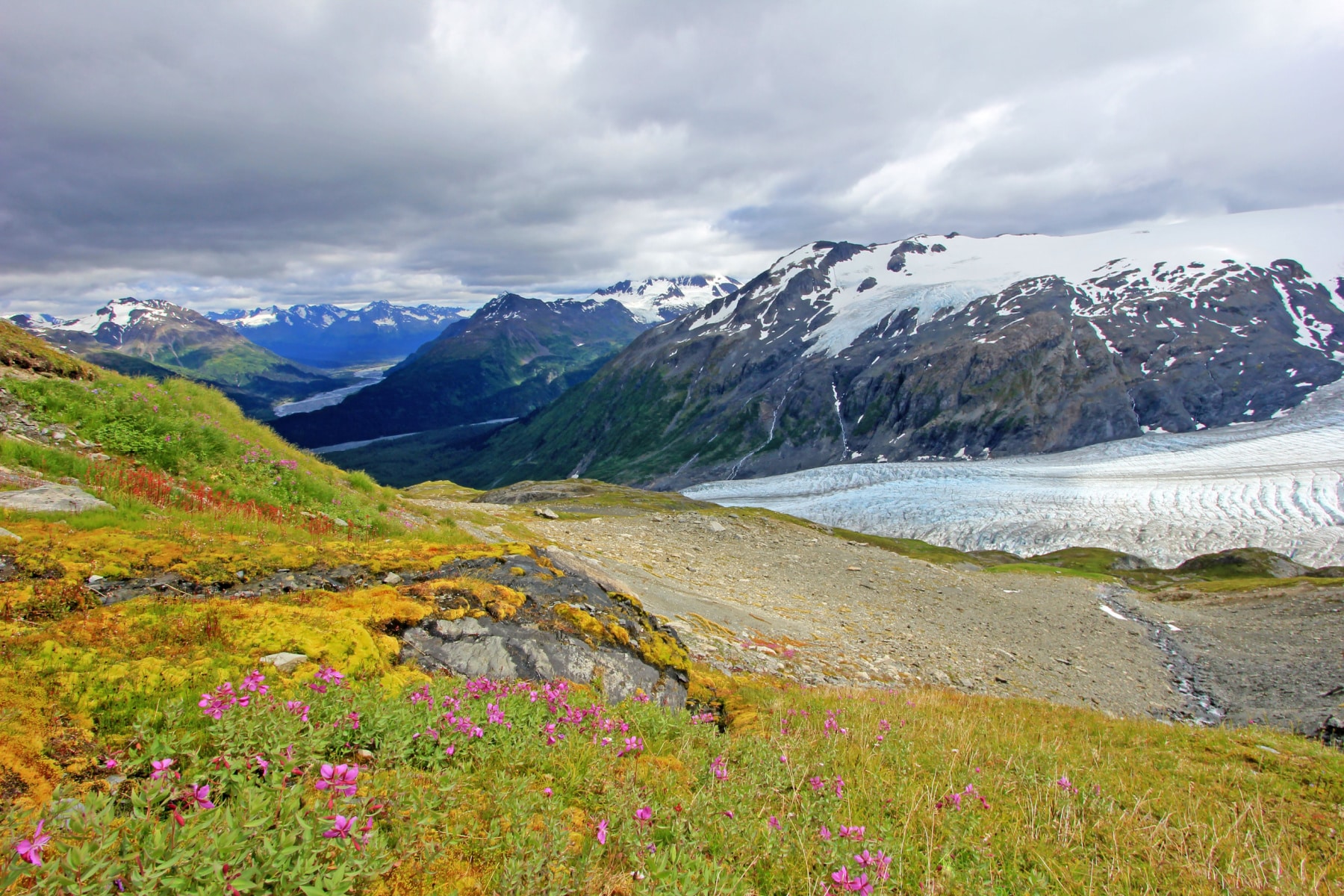
Article Overview: Hiking the Harding Icefield Trail in Kenai Fjords National Park
The Harding Icefield Trail in Kenai Fjords National Park’s ascent takes you on an 8.2-mile roundtrip adventure rising from coastal forests through alpine tundras to expansive views of the icefield, spanning 700 miles.
You could put Sequoia National Park inside the Harding Icefield Trail in Kenai Fjords National Park and then some. The icefield covers an entire mountain range, is deep enough to fit three Empire State Buildings underneath it, and connects 38 glaciers, a dozen of which are in Kenai Fjords National Park near Seward, Alaska.
My name is Jennifer, and I was born with wanderlust that has taken me from the depths of the desert to the peaks of the Rockies. Now, I want to share my experience in Alaska on the Harding Icefield Trail so you can have the same amazing experience as I did (and learn from my missteps).
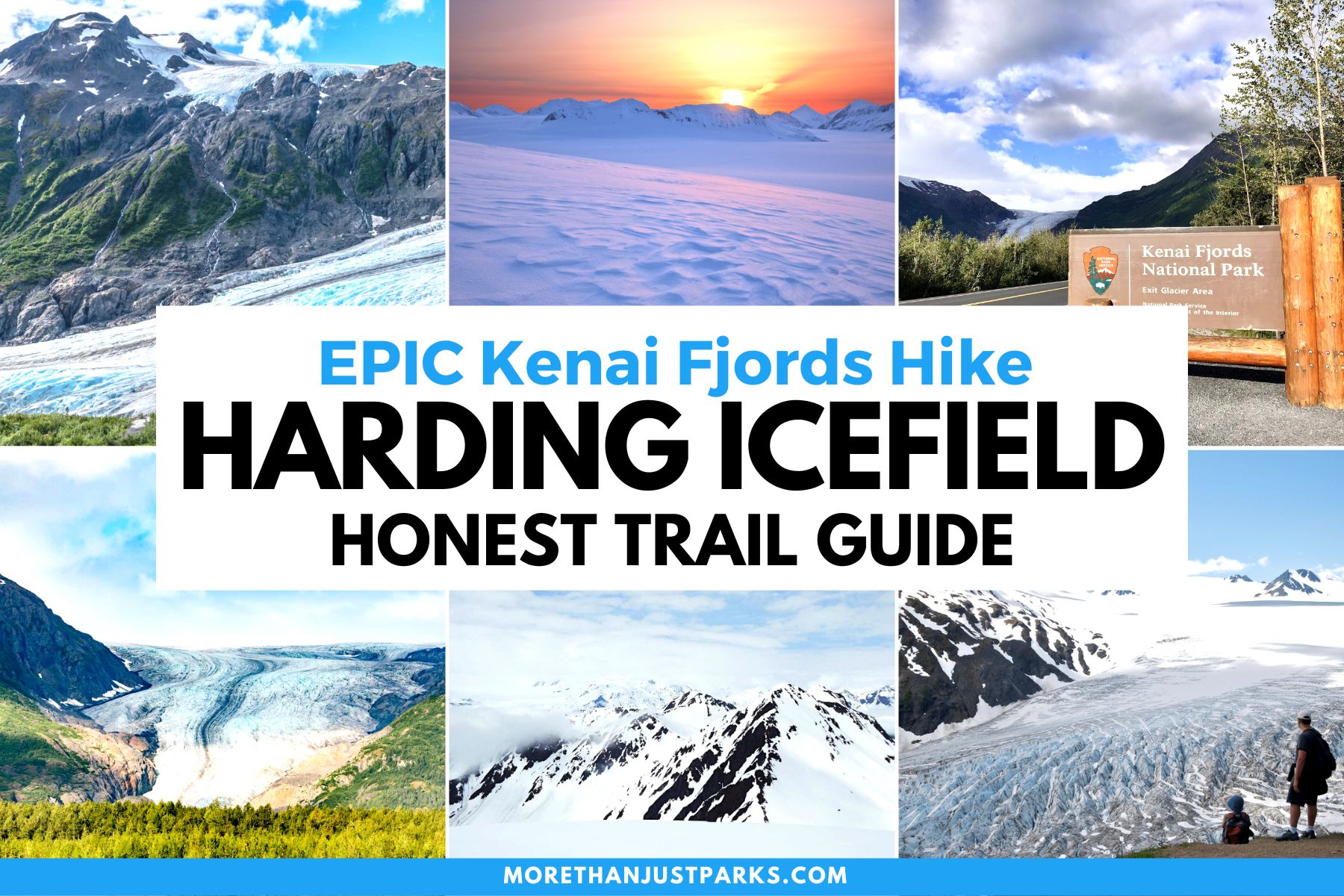
Harding Icefield Trail in Kenai Fjords
Table of Contents: Harding Icefield Trail in Kenai Fjords
Table of contents: Harding Icefield Trail in Kenai Fjords
- Harding Icefield Trail in Kenai Fjords
- 5 Quick Things to Know Before Visting Kenai Fjords National Park
- Hiking the Harding Icefield Trail Step-by-Step Guide
- The Best Time to Hike Harding Icefield Trail
- Getting to the Kenai Fjords National Park
- Safety Steps for Harding Icefield Trail in Kenai Fjords National Park
- FAQ – Hiking the Harding Icefield Trail in Kenai Fjords National Park
- Is Harding Icefield Trail in Kenai Fjords National Park Worth It?
- Map of the Harding Icefield Trail
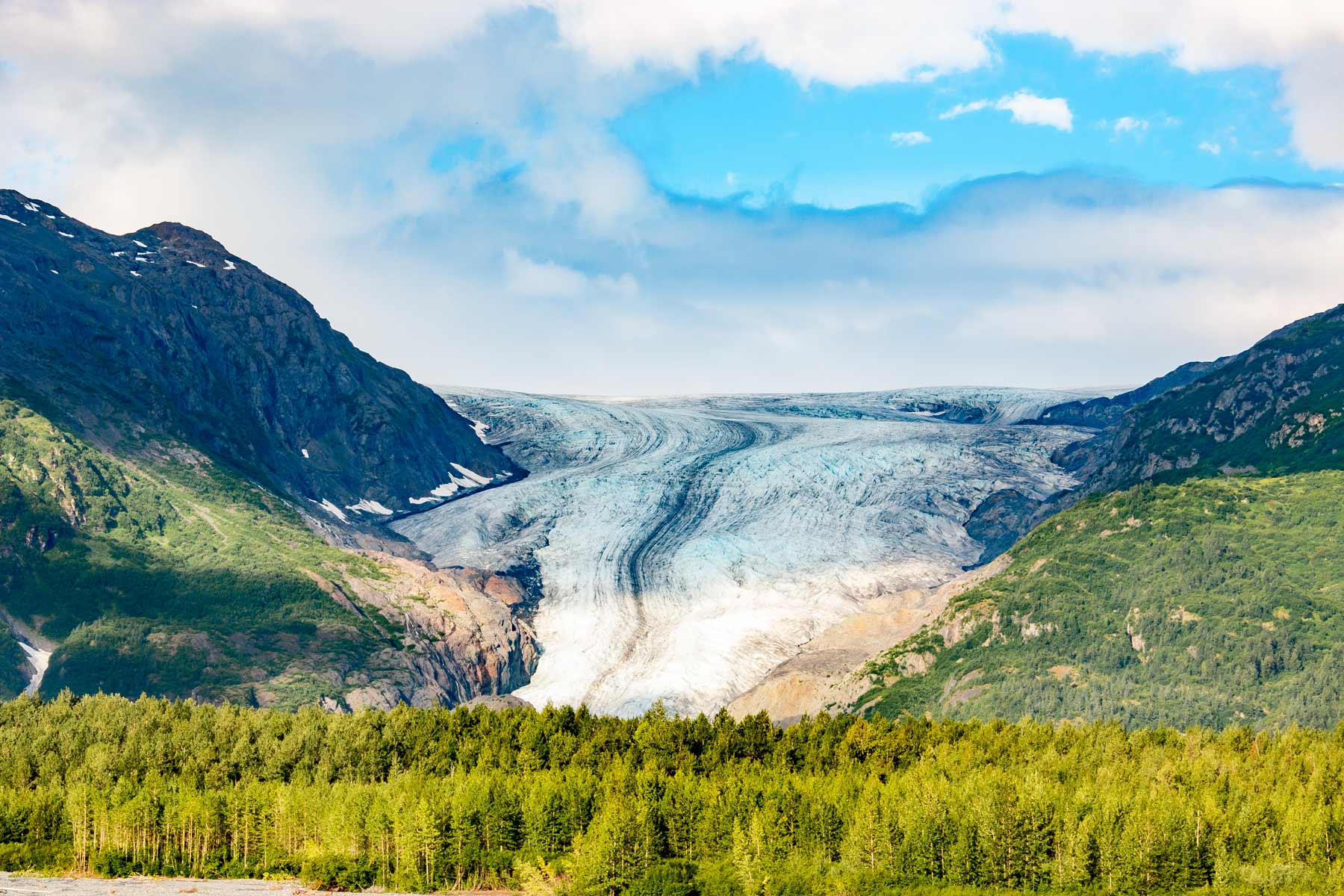
5 Quick Things to Know Before Visting Kenai Fjords National Park
- Kenai Fjords National Park is FREE. No admission is charged for cars or individuals. If you purchase an America the Beautiful Pass for just $80, you won’t have to worry about admission prices for a year across 2,000+ preserved lands.
- Here are a few things that immensely helped my hike. This guidebook, this waterproof map, my favorite eco-friendly sunscreen, and this bug spray.
- You definitely need bear spray when taking the Harding Icefield Trail. Several sections make it hard to see an incoming bear. Wear it on your hip for easy access.
- Glacier sunglasses to prevent snowblindness. These sunglasses stay on snugly!
- This is my favorite hotel in/around Kenai Fjords National Park. Free shuttle AND breakfast? Yes, sir!
Hiking the Harding Icefield Trail Step-by-Step Guide
Read the bulletin board at the start of the Harding Icefield Trail. It contains important information like avalanche risks and, in our case, an aggressive bear warning. Be sure to sign the guestbook, which also helps park rangers know who is on the trail.
We took the Glacial Loop Trail around to get a look at the Exit Glacier before we started the ascent. You’ll meet up with the Glacial Overlook Trail before you get to the trailhead for Harding Icefield Trail.
What is Exit Glacier?
ALWAYS CHECK THE TRAIL CONDITIONS NEAR EXIT GLACIER BEFORE TAKING THE SCENIC PATHS
Exit Glacier is a “Valley Glacier” that “exits” the larger Harding Icefield in Kenai Fjords and ends in a valley.

The Ascent of Harding Icefield Trail
The Harding Icefield Trail spans 4.1 miles one way with an average elevation gain of 1,000 feet every mile. This was not intimidating to me. It should have been. The first switchbacks are just a warm-up of what’s to come.
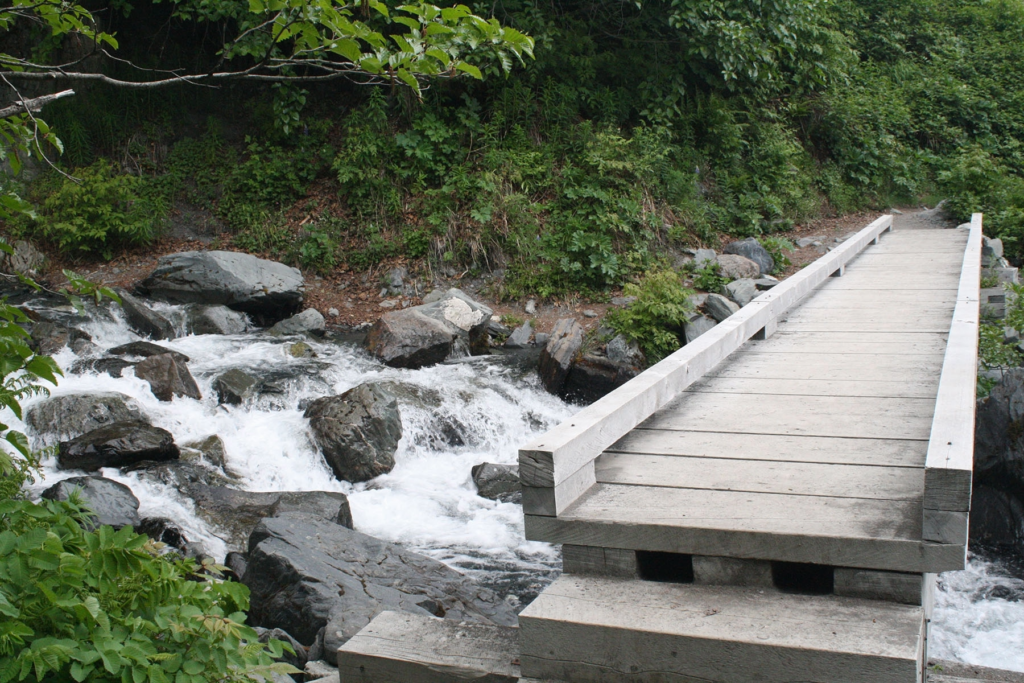
Wooden Bridge Milemarker: 922′ Elevation
This wooden bridge over a glacial stream is a perfect first rest point to catch your breath.
Prime bear country fills the next half mile or so on the way to Marmot Meadows. The narrowness of the trail and the thick brush offered a reminder of the “Hey Bear! Woah Bear” cry you should make as you walk through bear territory.
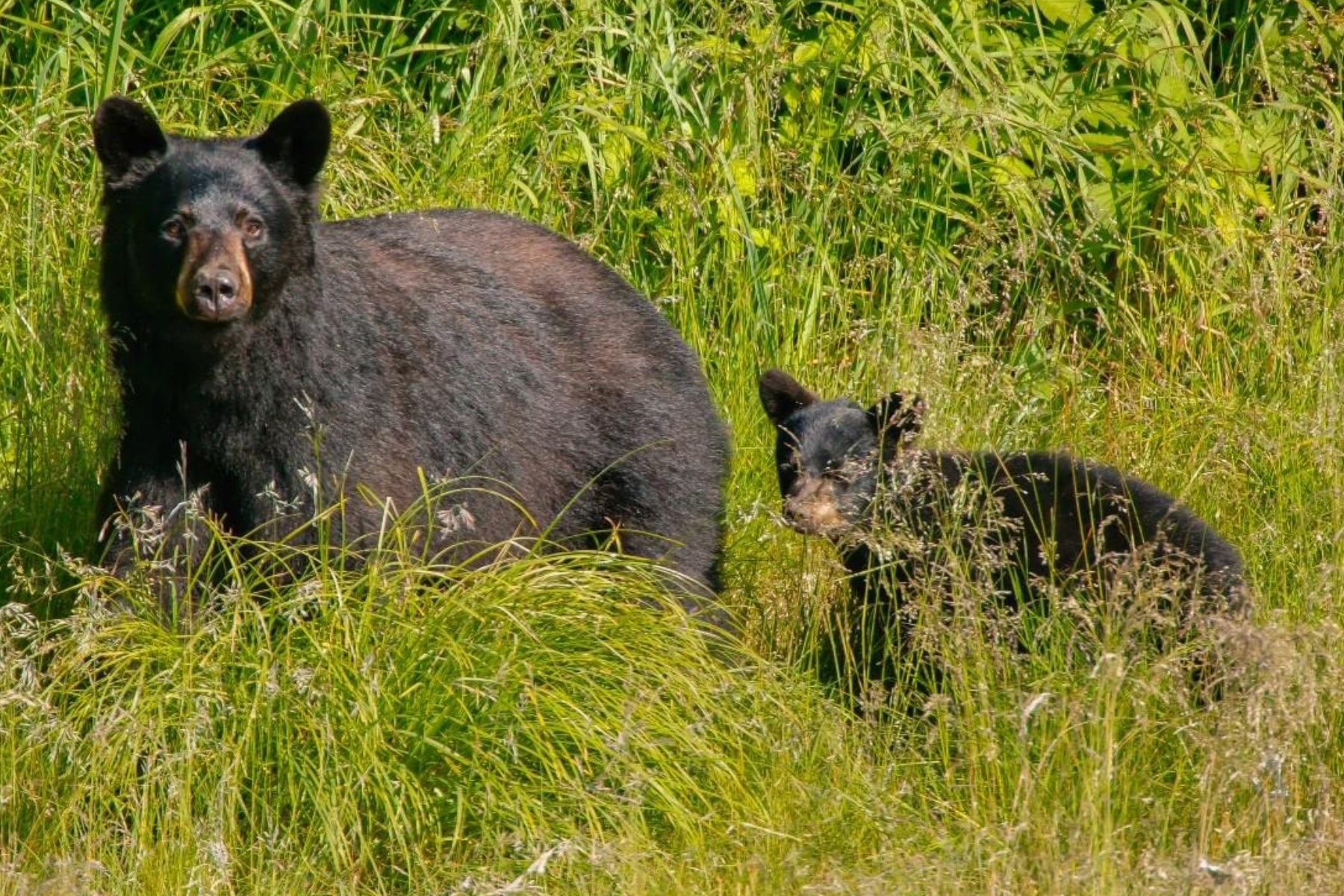
Marmot Meadows
Elevation: 1,572 feet
You’ve earned the break you get at Marmot Meadows on Harding Icefield Trail in Kenai Fjords, about 1.5 miles into the trail. Also known as “lunch rock,” take some time to fuel up for the next ascent with an epic look at Exit Glacier.
You still have 2.6 miles ahead of you, but this view could make a good turnaround point if the steepness of the trail is too challenging.
The Marmot Meadows name comes from the hoary marmot, which was once abundant here. While those numbers dwindled due to plant growth, you might hear one whistle at you from time to time.
TRAVEL TIP: If you really want to see whistling marmots, plan a trip to the Skyline Trail in Mount Rainier National Park.
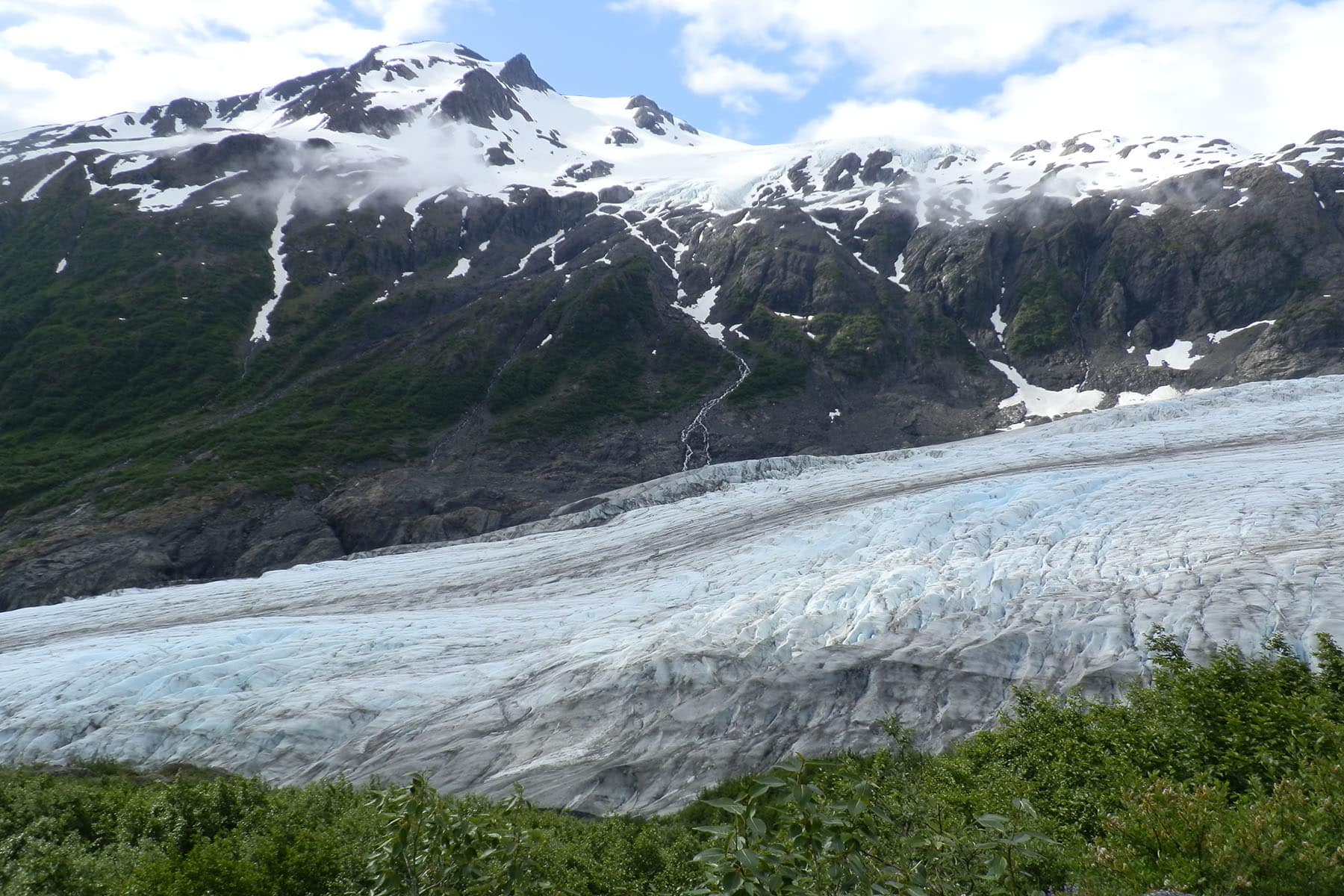
Bottom of the Cliffs
Elevation: 1,788 feet
The next 0.4 miles of the Harding Icefield Trail weave through more meadows, but you’ll keep the Exit Glacier at your left while the narrow, wooded trails have opened up to a “The hills are alive with the sound of music” landscape.
Especially at the height of wildflower season in the summer, the views become more vibrant with each step.
Take a swig of water and stretch out those calves – it’s time to take the switchback stretch, what I consider the hardest part of the Harding Icefield Trail in Kenai Fjords National Park.
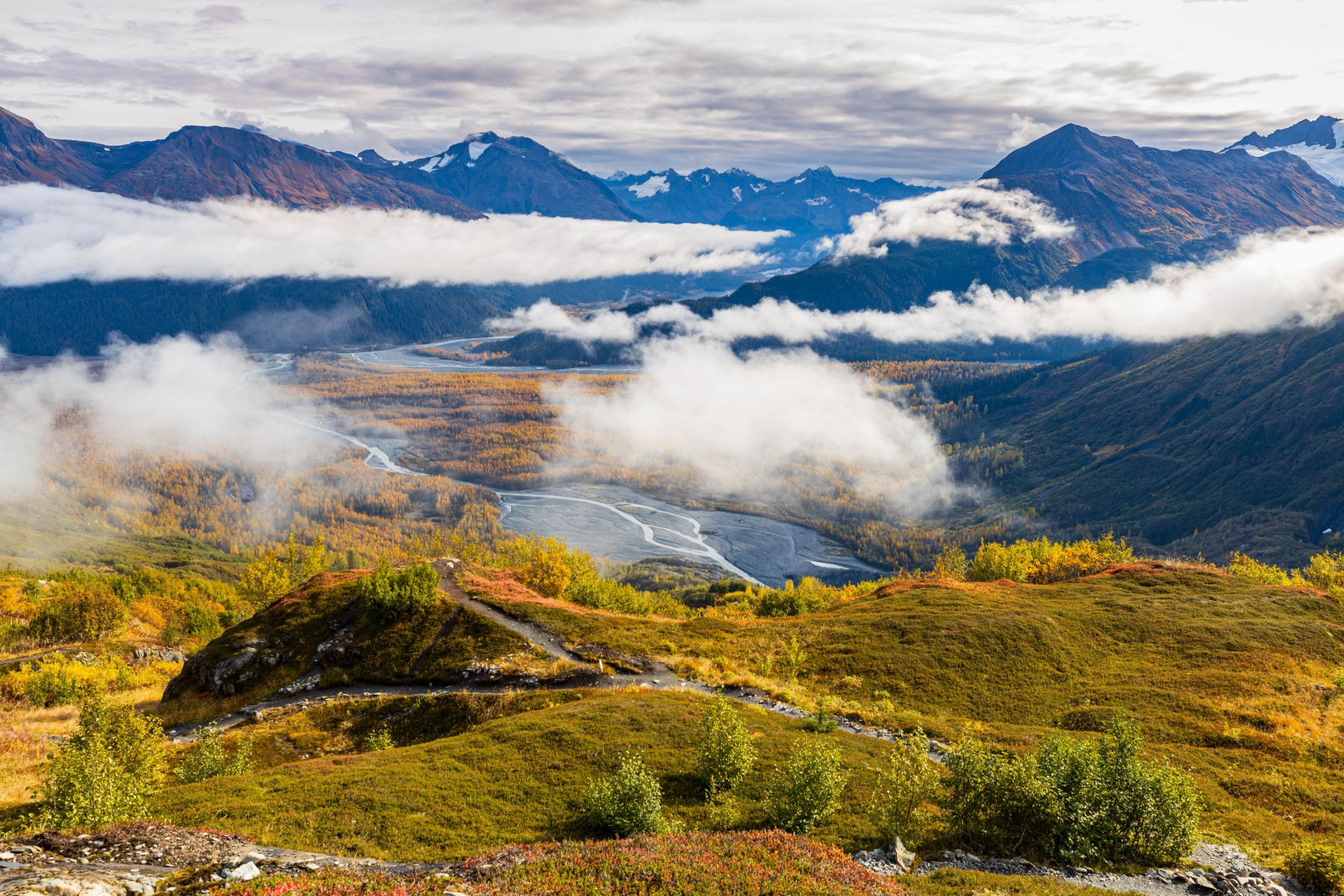
Top of the Cliffs
Elevation: 2,452 feet
The Harding Icefield finally comes into view at the Top of the Cliffs along with the nunataks. If you are physically able, I highly recommend at least making it this far. That would make the roundtrip on the Harding Icefield Trail 4.8 miles long.
Snow covers portions of, if not all, of the trail well into July. This is where you should stop during avalanche advisories unless you are prepared for mountaineering and have an avalanche probe, shovel, and transceiver (and know how to use them).
While the snow hangs on, orange flags will mark the trail.
DID YOU KNOW? The nunataks have 4,000 feet of compacted snow and ice all the way down.
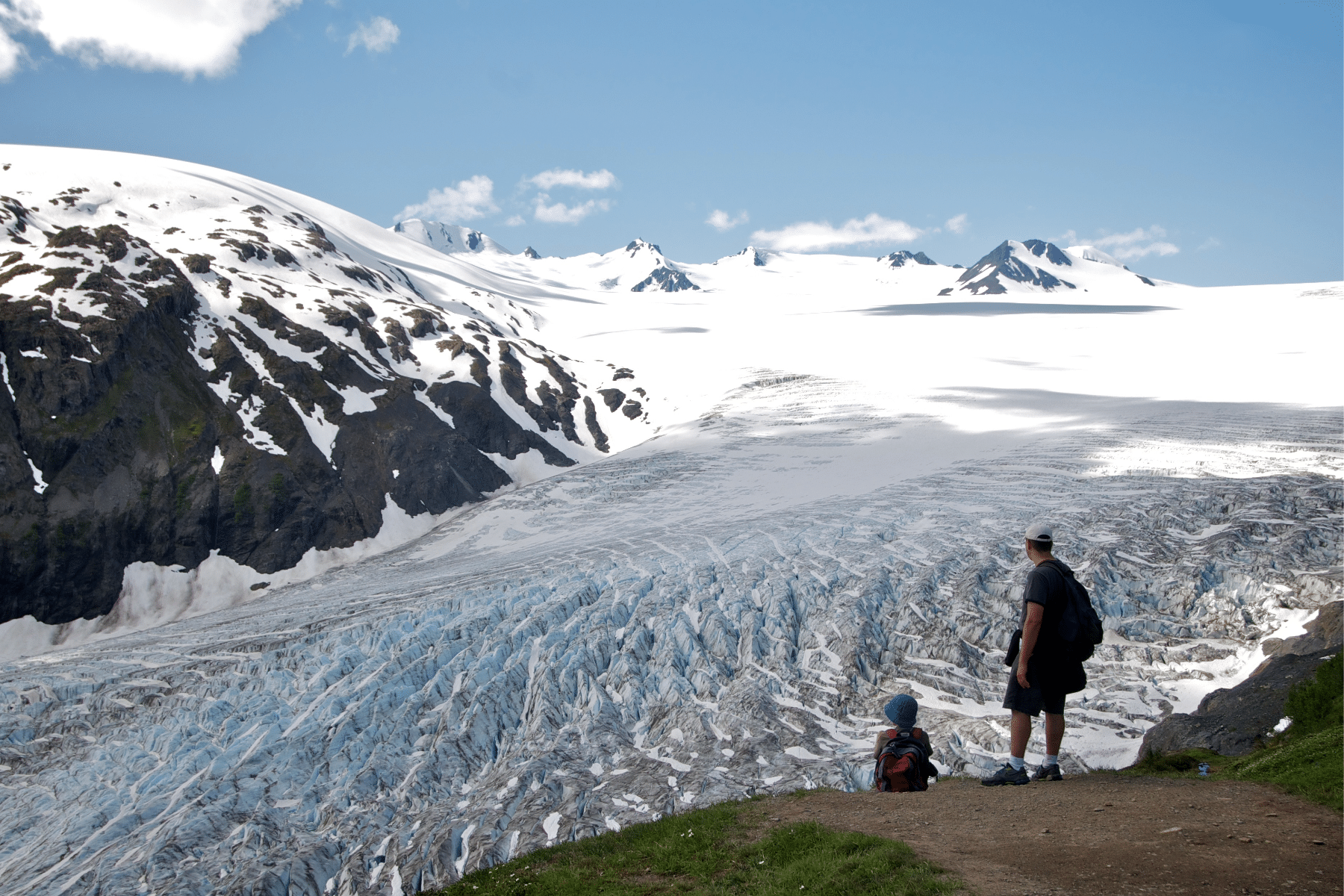
The Harding Icefield Trail in Kenai Fjords Final Stretch
Emergency Shelter: 3,459 feet
Here we have a good news/bad news situation. First, the good news – the 1.7 miles to the end of the trail aren’t nearly as steep. Bad news – the winds can knock the breath out of you, and if there’s any chill in the air, it will rattle your bones.
This section of the Harding Icefield Trail in Kenai Fjords has a certain “Winter Is Coming”/Game of Thrones feel to it. Dark rocks mixed with sections of snow make it feel otherworldly.
The unpredictability of the weather in Kenai Fjords National Park is why the emergency shelter sits here. You can’t rent it or camp inside it. It’s only to escape threatening weather conditions on the Harding Icefield Trail.
If you lose sight of the orange flags in the snow, look for the emergency shelter atop a hill near the trail end and walk toward it.
Fascinating Fireweed
I wanted to share a fascinating little fact about the purple plants called “Firewood” you’ll find in this section. Fireweed grows abundantly here because it can survive the extreme climate of Alaska.
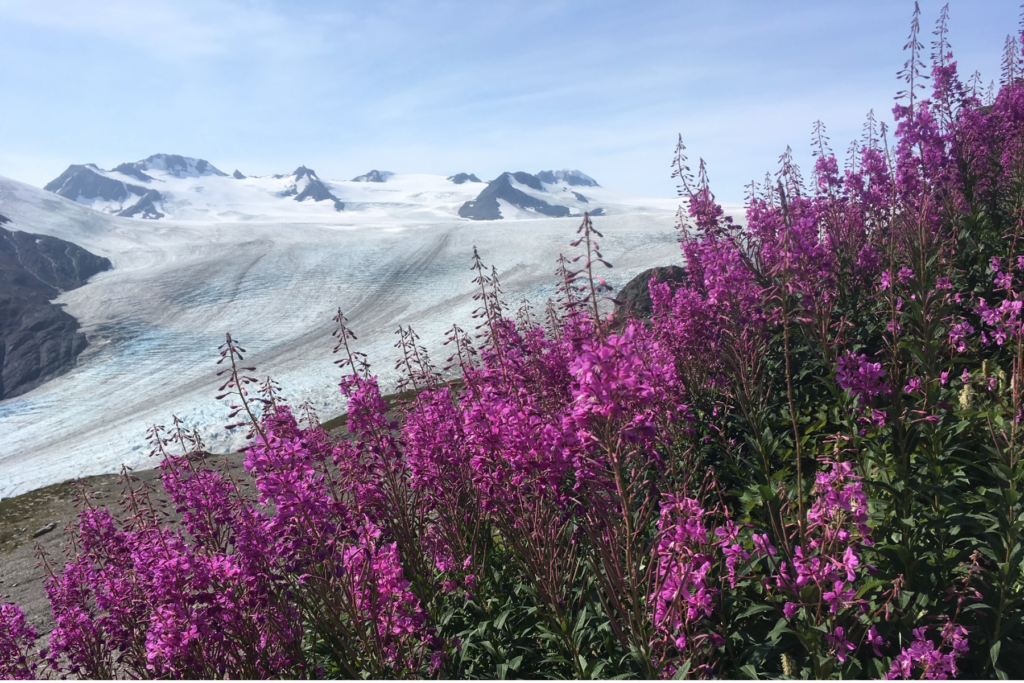
Why is it called Fireweed?
“Fireweed gets its common name in the United States because it’s notoriously associated with fire landscapes. It quickly colonizes disturbed areas. It was one of the first plants to appear after the catastrophic eruption of Mount St. Helens in Oregon.“
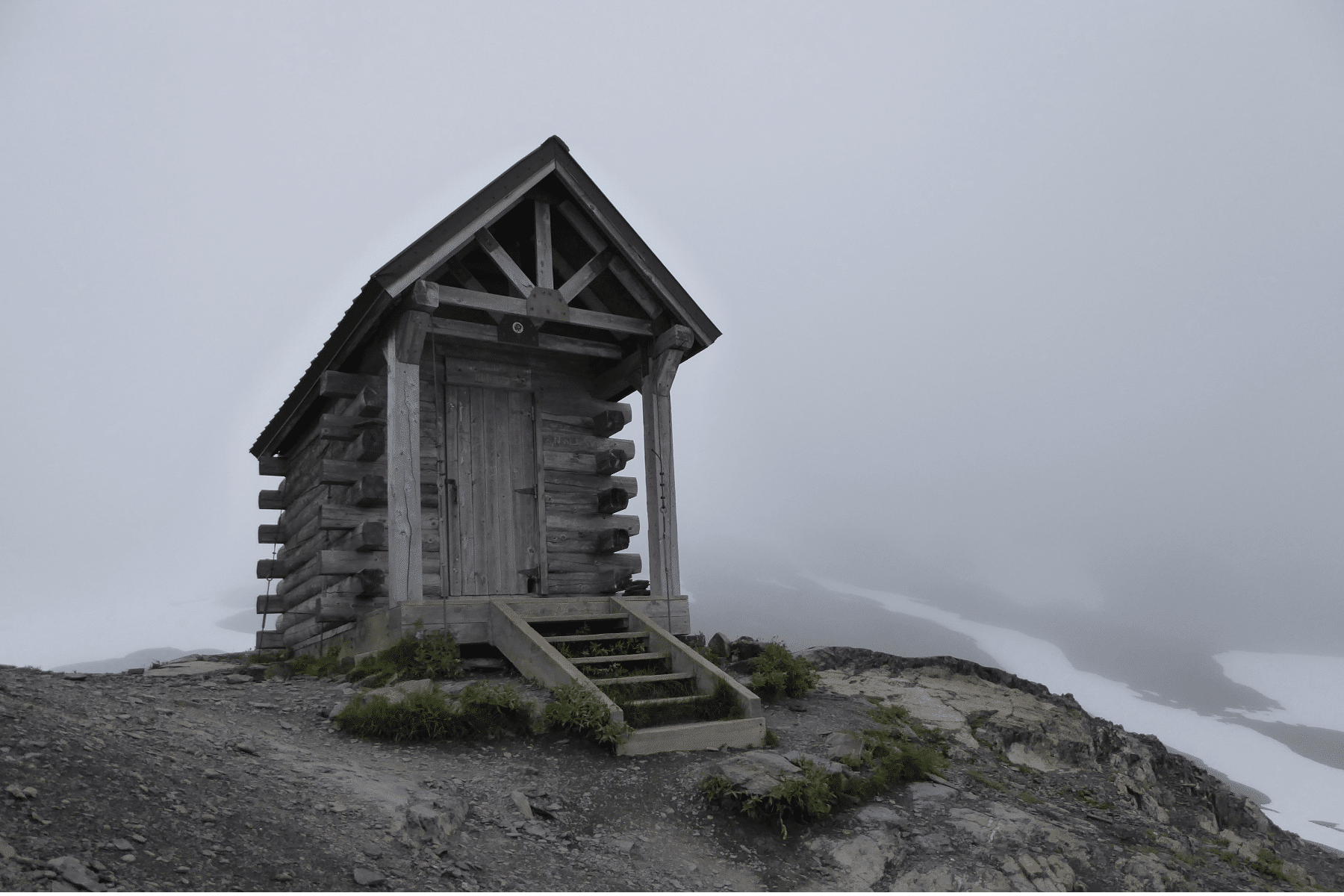
The End of the Harding Icefield Trail in Kenai Fjords National Park
Finally, we arrived at the top of the Harding Icefield Trail in Kenai Fjords National Park. Icefields are devilishly misleading because you just want to keep going. The sediment hill (scree) offered no confidence it was worth taking the risk.
The Harding Icefield is a 700-mile behemoth, and you’re just seeing a slice of it here.
Eventually, fog settled in, and clouds a little too dark for my comfort level began rolling in. The trek back down the Harding Icefield Trail could have been faster, but slippery conditions and intermittent rain slowed us down.

The Best Time to Hike Harding Icefield Trail
The best time to hike the Harding Icefield Trail in Kenai Fjords is July through September when you’ll actually be hiking and not mountaineering.
The summer months also mean more things to do in Kenai Fjords National Park, like taking a boat tour of the fjords.
Visiting during winter means as little as six hours of daylight. Boat tours become limited, if not impossible, to find from late September to early March due to rough seas.

Getting to the Kenai Fjords National Park
Getting to the nearest town of Seward means hopscotching some transportation options. No commercial flights come out of Seward, leaving Ted Stevens Anchoring International Airport as the best option. From there, you’ll need a rental car to get to Seward. You will drive for 2.5 hours.
Other options include:
Additionally, you’ll need to get to Kenai Fjords National Park from Seward, which adds another 12 miles to the drive. You can also park in Seward and use a shuttle or taxi service to get into the park.
TRAVEL TIP: The road to Exit Glacier, Herman Leirer Road, is closed during the winter at mile 1.3, where the road intersects with Old Exit Glacier Road. You can still access the park and Harding Icefield Trail by snowmobile, snowshoes, cross-country skiing, or fat bike.
CHECK ROAD CONDITIONS AND CLOSURES THROUGH ALASKA DEPARTMENT OF TRANSPORTATION
Finally, you’ll reach the Exit Glacier Nature Center, and you are about to take the journey on a steep turn of Harding Icefield Trail.
Safety Steps for Harding Icefield Trail in Kenai Fjords National Park
Beyond avalanche risks and slippery trail sections, you need to be aware of some Alaskan-sized risks on the way to the top of Harding Icefield Trail in Kenai Fjords National Park.
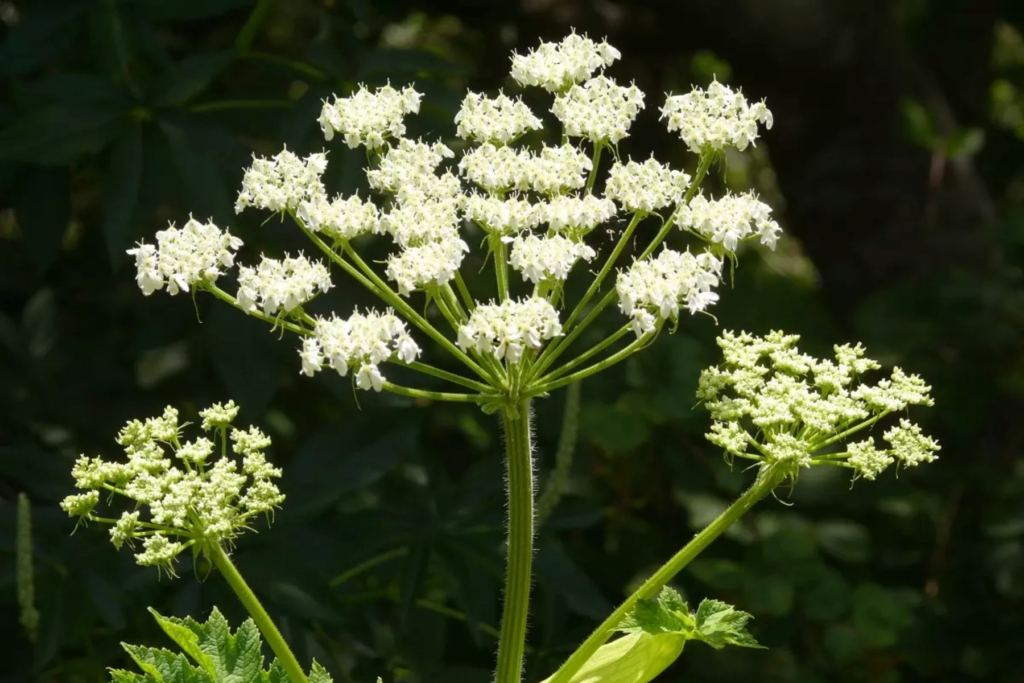
Cow Parsnip, aka “Pushki”
Be on the lookout for this plant. The leaves have a defense mechanism to fight off attacks, but the chemical can also cause intense itches, blistering burns, and pain.
Especially when exposed to sunlight, these wounds can last up to two months, with pigmentation discoloration for up to two years.
Salmonberries
The Harding Icefield Trail in Kenai Fjords National Park passes through a thicket of Salmonberries. While the park rules allow you to collect “small quantities,” the hungry bear that feeds off these sweet treats poses the real risk.
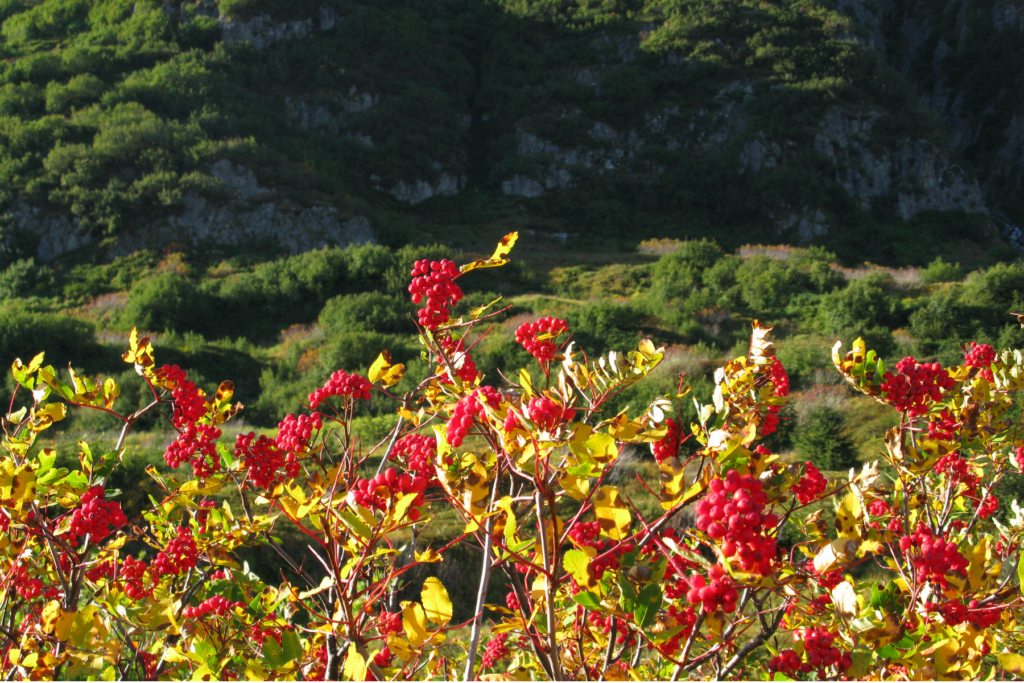
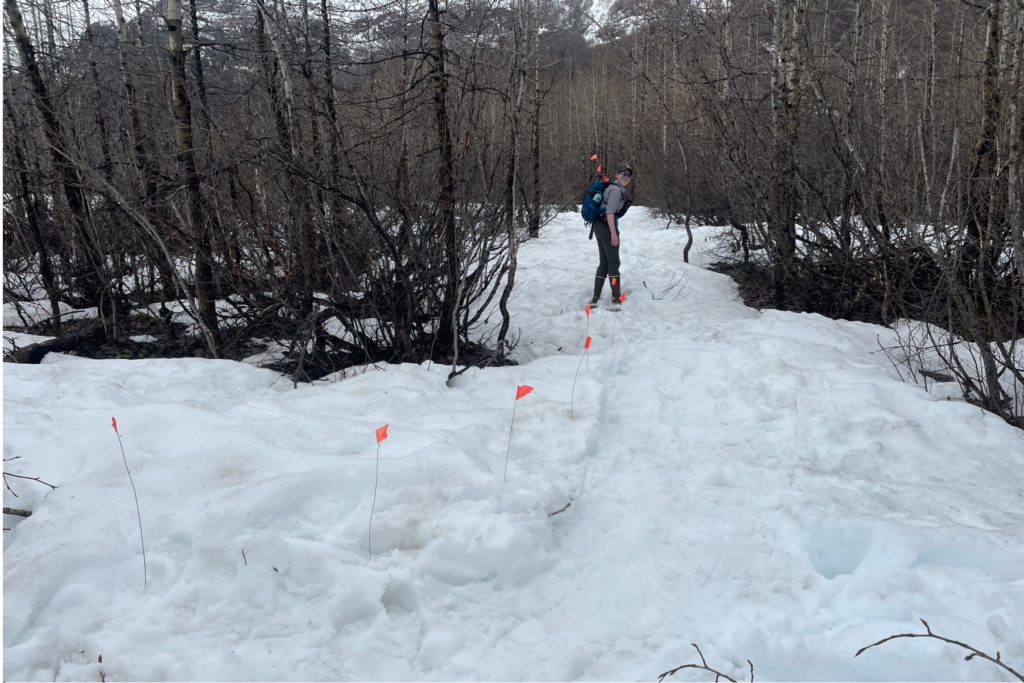
Follow the Orange Flags
Here’s an example of the orange flags in the snow. They not only keep you on the trail but also prevent people from walking on the sensitive vegetation underneath.
FAQ – Hiking the Harding Icefield Trail in Kenai Fjords National Park
A handful of the most expert-level mountaineers will attempt the walk the Harding Icefield in Kenai Fjords each year. That is considered a backcountry hike and should be done through an expert tour guide service based in Seward.
It’s the same reason water and the sky look blue. The long wavelength on the color spectrum, like red, gets gobbled up by the glacier. Concurrently, that leaves the short wavelengths of blue bouncing off the ice crystals within.
The strenuous trail takes six to eight hours, but conditions along the way could slow you down. You’ll also get the benefit of a lot of daylight during summer. From April 22 through August 21, the skies never turn to night.
Is Harding Icefield Trail in Kenai Fjords National Park Worth It?
In all seriousness, hiking Harding Icefield Trail in Kenai Fjords is not only worth it, but it’s something that should take priority over places that aren’t feeling the effects of climate change so dramatically. In the Kenai Fjords National Park plan for 2004, one of the goals was to promote the park as a place to “touch a glacier.”
The 2018 plan told a different story, with four different options to promote the park, knowing that Exit Glacier is retreating.
“The NPS could also rebrand, divert, or provide appropriate and safe experiences to address the visitor expectation of touching ice—formalizing the mountaineering route off of the Harding Icefield may be one solution. Additional accessible trails should be considered, given the potential increase and diversity of visitors.”
kenai fjords national park, Scenario Planning Discussions for the Future Frontcountry
Management Plan, 2018
Give Your Input for the Future of Kenai Fjords National Park
As park officials work to bring visitors to the park while dealing with glacial retreats and the preservation of the natural landscape, your input is valued. If touching a glacier is important to you, let them know! Here’s how to participate.
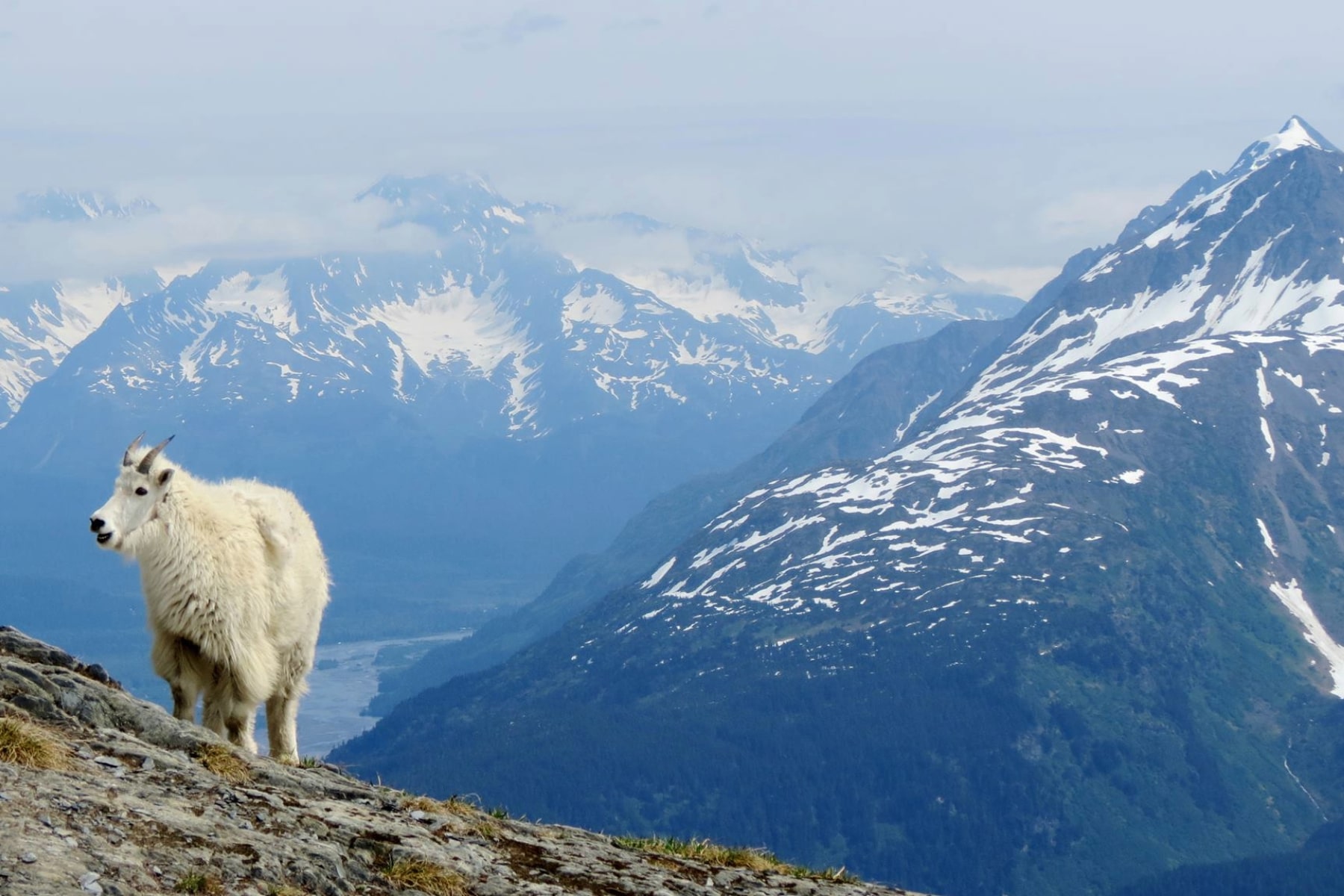
Terminology of Harding Icefield Trail in Kenai Fjords National Park
After spitting on myself several times while learning to say “fjord” (say “Fee-yord” really fast as one syllable), I found that ice means more than just frozen water. Here are some terms to help you avoid the rabbit hole of research.
- Fjord: A fjord is a long, narrow sea inlet that forms when a glacier cuts a U-shaped valley that later fills with seawater.
- Icefield: A large expanse of interconnected glaciers covering an area of at least 3 miles.
- Glacier: A persistent body of dense ice that is constantly moving under its own weight, formed from the compaction and recrystallization of snow.
- Nunatak: (“Noon-uh-tack”) Nunataks are isolated peaks of rock or land projecting above glacial ice fields or sheets.

Map of the Harding Icefield Trail
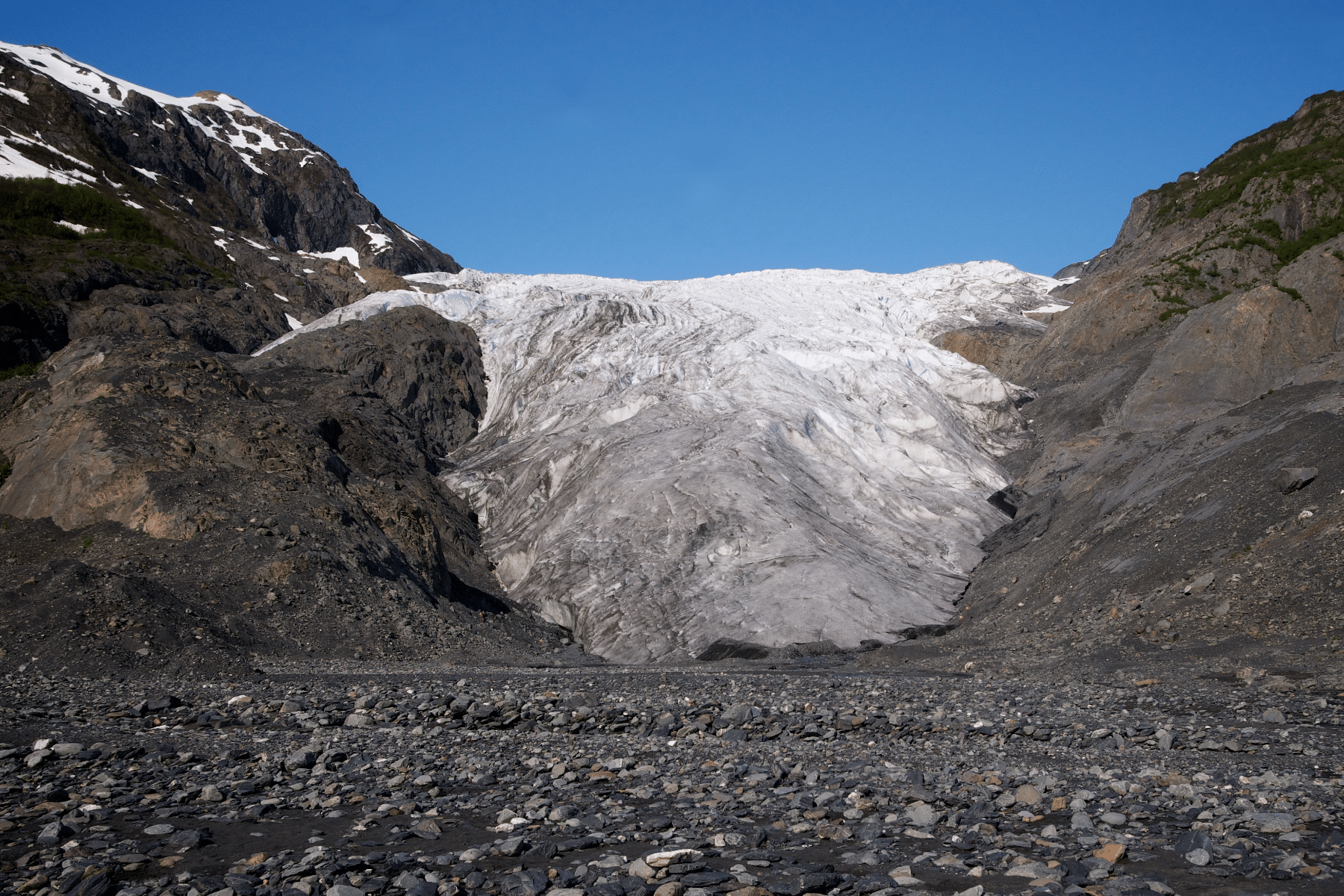
Pin the Harding Icefield Trail in Kenai Fjords
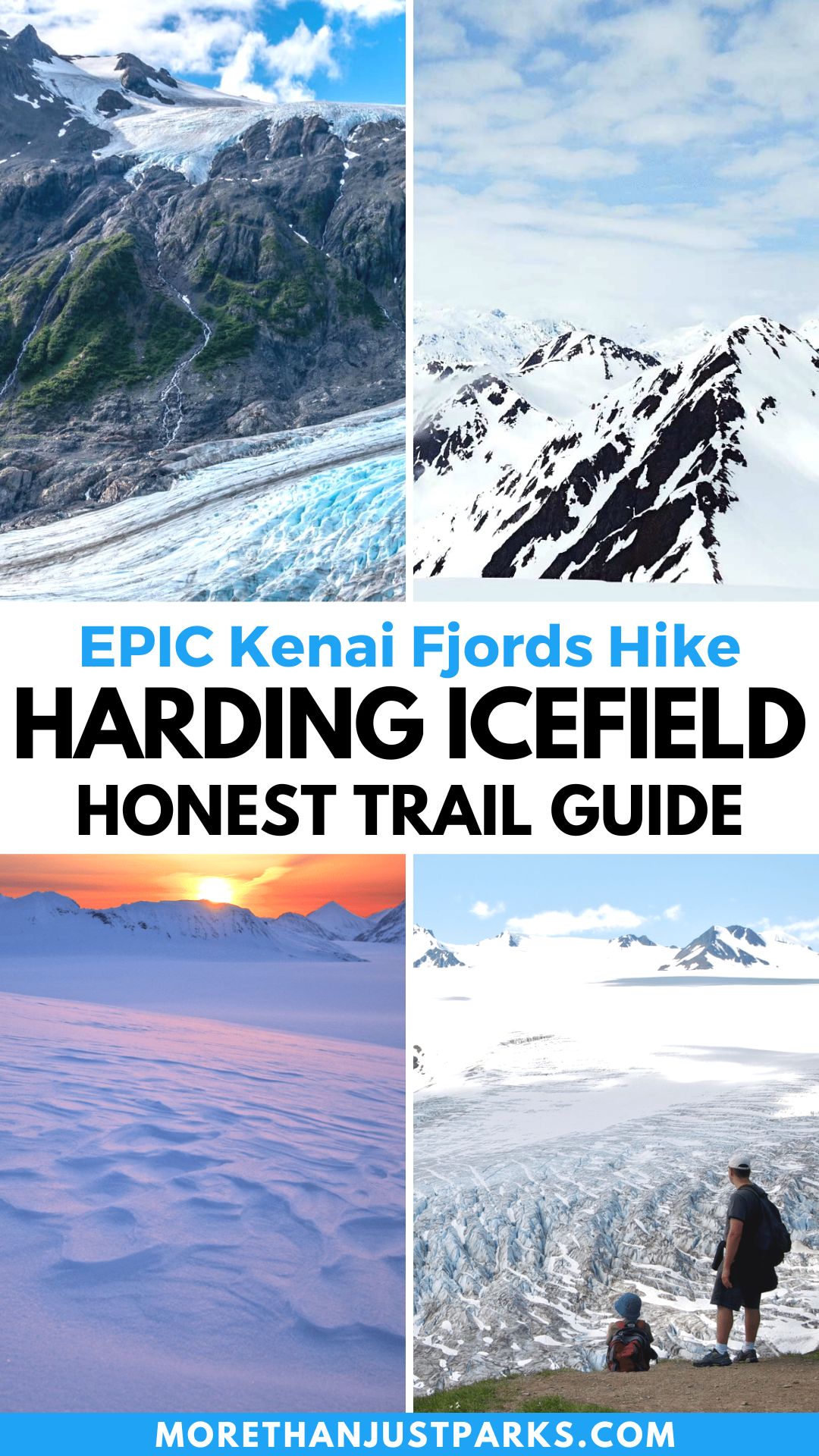

Helpful Related Links
Best National Parks in Alaska: 8 EPIC Alaska National Parks
Don’t Leave Alaska Without Seeing These Landmarks: 15 MUST-SEE Alaska Landmarks
Kanai Fjords vs. Denali: 20 EPIC Things to Do in Denali National Park
Explore the Glaciers of Montana: Try These 15 Amazing Things to Do on Your Visit to Glacier National Park‘
Too Cold? Head to Death Valley to Heat Up: 25 AMAZING Things to Do in Death Valley National Park
TRIVIA TIME: What are the Largest National Parks?: 15 LARGEST National Parks in the United States
Prefer Hawaii Over Alaska?: Visiting Haleakalā National Park
harding icefield trail in kenai fjords, hiking the harding icefield trail in kenai fjords national park, harding icefield hike kenai fjords, harding icefield trail in kenai fjords, hiking the harding icefield trail in kenai fjords national park, harding icefield hike kenai fjords, harding icefield trail in kenai fjords, hiking the harding icefield trail in kenai fjords national park, harding icefield hike kenai fjords, harding icefield trail in kenai fjords, hiking the harding icefield trail in kenai fjords national park, harding icefield hike kenai fjords,

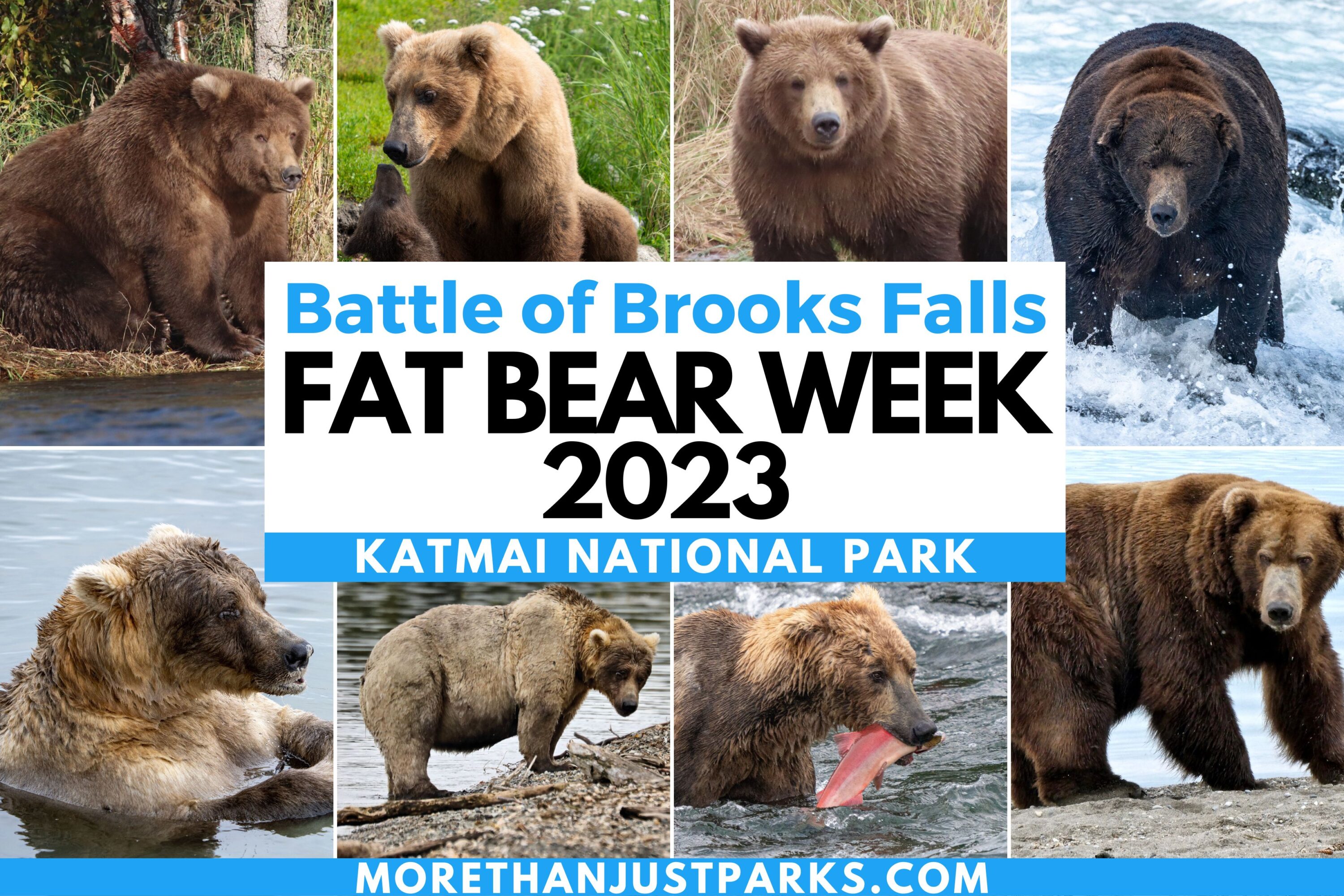
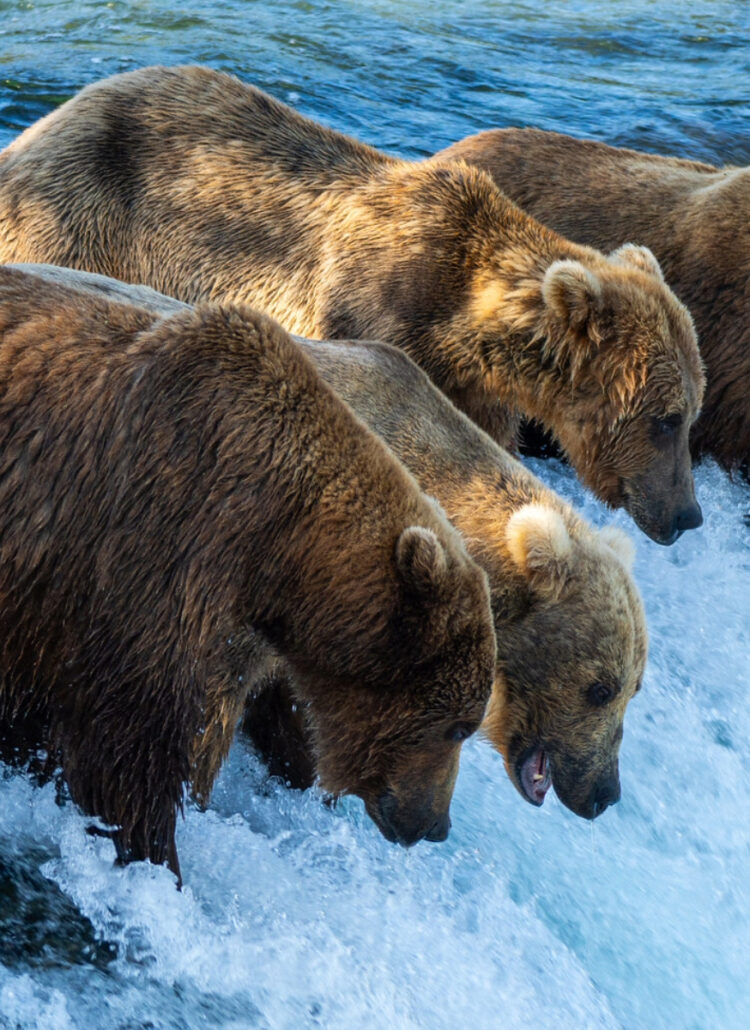


Of all the Alaska parks, is this the one you’d recommend most?